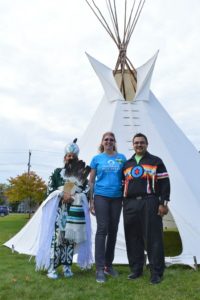Sarnia-Lambton Tourism looking to expand First Nations cultural events

By Colin Graf
SARNIA— Tourism may be the growth industry of the future for First Nations in southwestern Ontario, local officials hope. A cultural event in Sarnia earlier this fall has planted seeds for growing new ways to use Canadians’ interest in First Nations’ culture for economic growth.
The event attracted some 250 people, both regional tourism developers and First Nations representatives, to hear from speakers about how other communities in Ontario are developing tourism on their territory, says Phyllis George, General Manager of the Tecumseh Community Development Corporation, an organization providing business funding for 10 First Nations in southern Ontario.
Featuring craft vendors, dancers, drummers, and traditional foods, the event was intended “to promote entrepreneurship,” among members of the First Nations, George says. After a welcome by Aamjiwnaang Chief Chris Plain, the group heard presentations from Kevin Eshkawkogan, CEO of Indigenous Tourism Ontario, and learned how to apply for starter grants for tourism ventures.
“A lot of non-[Indigenous people] are curious and they may even go to powwows and want to know about the dances, but there’s so much more than that,” George says on the awareness and interest about First Nations growing in Canada, citing the growth of First Nations-led fishing and hunting camps as an example. “It’s Important for others to know and understand our culture and traditions.”
George believes that First Nations citizens can be the key to showing that to the rest of the country. Some southern Ontario First Nations have campgrounds, golf courses, and bed-and-breakfasts on their lands, and some produce and sell their own maple syrup. George expects these types of ventures along with cultural tourism events to expand in the future.
Regional tourism officials started working with George and other First Nation citizens over a year ago to start planning the recent event, says Beverley Horodyski, product development coordinator for Tourism Sarnia-Lambton. The idea was born after the two women went to a regional tourism conference in London, Ont. and started sharing ideas about including the three regional First Nations, Aaamjiwnaang, Chippewas of Kettle & Stony Point, and Walpole Island First Nation, in tourism planning. Since Horodyski’s job is working with tourism businesses to create new attractions and to tie in history, heritage and culture, she says reaching out to the First Nations was a natural step.
The Southern First Nations Secretariat and the Western Ontario Community Futures organization were also involved in putting the event together.
George and Horodyski hope to hold another event next year, to showcase the heritage and history of the local First Nations. Discussions have begun between the tourism office and Aamjiwnaang to develop a product that would be ready for the marketplace to entice tourists to the area. Talks are “in very early stages,” says Horodyski, and it’s too soon to say if their plans would be a museum or an experience where visitors would come down to the community centre and be part of an activity. “ It could take a number of different forms.”
“Possibly the most important thing to come out of the recent event is introducing the Tecumseh staff to the local tourism promoters so they can work on new ideas together,” says Horodyski.
Other discussions are underway about new initiatives the two groups may work on, but plans are too preliminary to discuss.
“Stay tuned,” she says. “We see such potential here, and with the success of this event, we hope to do it again next year” and add more vendors, and discuss new plans.”


